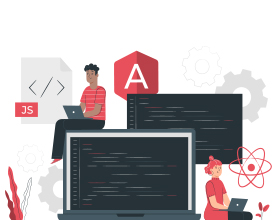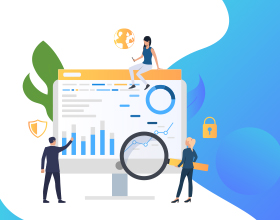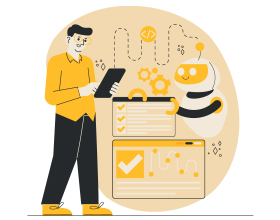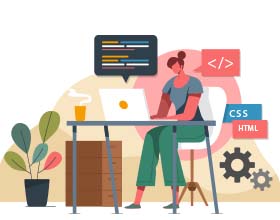- 13-Jan-2023 08:25 pm
- 54 Viewed
- 0 Comments
The evolution of Online IT learning and technologies has significantly impacted the way we acquire knowledge and skills in the field of information technology. In the past, individuals interested in learning about IT had to attend physical classrooms or workshops, which often required a significant time and financial commitment. However, with the advent of the internet and the widespread adoption of online learning platforms, it is now possible to learn about IT from the comfort of one's own home or office, at a pace that suits the individual learner.
One of the earliest forms of online IT learning was through the use of online tutorials and video lectures. These resources, which were often hosted on websites or YouTube, allowed individuals to learn about specific IT topics by following along with the instructor's explanations and demonstrations. As the internet evolved, so too did the quality and variety of online IT learning resources. Today, there are a wide range of options available, including interactive courses, virtual classrooms, and even virtual reality (VR) experiences.
One of the key drivers of the evolution of online IT learning has been the advancement of technology. In the early days of the internet, most people accessed it through desktop computers, which limited the types of learning experiences that were possible. With the advent of smartphones and tablets, it is now possible to learn about IT on-the-go, at any time and in any location. This has opened up a whole new world of learning opportunities for individuals who may not have had the time or resources to attend physical classrooms.
Another factor that has contributed to the evolution of online IT learning is the increasing demand for IT skills in the job market. As technology becomes more integral to all aspects of life and business, there is a growing need for individuals with a wide range of IT skills, from basic computer literacy to advanced programming and data analysis. Online IT learning platforms have helped to meet this demand by providing accessible and affordable learning opportunities for individuals looking to acquire these skills.
One of the most significant developments in online IT learning has been the growth of massive open online courses (MOOCs). These courses, which are often offered by top universities and institutions, allow individuals to take part in interactive courses that cover a wide range of IT topics. MOOCs have become increasingly popular in recent years, with millions of people around the world taking advantage of these learning opportunities.
How evolution of information technology has transformed teaching and learning?
The evolution of information technology (IT) has had a profound impact on teaching and learning. Some of the key ways in which IT has transformed teaching and learning include:
-
Increased access to information: With the advent of the internet, students now have access to a vast array of information and resources that were previously only available in libraries or through other limited channels. This has greatly enhanced the learning experience, allowing students to explore and learn about a wide range of topics in depth.
-
Improved collaboration and communication: IT has also transformed the way students collaborate and communicate with one another and with their teachers. Tools such as online forums, wikis, and collaboration software allow students to work together and share ideas in real-time, regardless of their location.
-
Enhanced multimedia learning experiences: IT has made it possible to create more engaging and interactive learning experiences through the use of multimedia content such as videos, simulations, and virtual reality (VR) experiences. This has made learning more engaging and has helped to hold students' attention and facilitate deeper understanding.
-
Increased flexibility and convenience: Online learning platforms and tools have made it possible for students to access learning materials and resources at any time and from any location, allowing them to learn at their own pace and on their own schedule. This has made learning more convenient and has opened up new opportunities for students who may not have been able to access traditional forms of education.
-
Greater personalization: With the help of IT, teachers can now use data analytics and other tools to track students' progress and tailor their learning experiences to their individual needs and learning styles. This has made learning more personalized and has helped to increase student engagement and achievement.
History of E learning
E-learning, or electronic learning, refers to the use of digital technologies to facilitate learning and teaching. The history of e-learning can be traced back to the 1960s, when computer-based learning systems were first developed. These early systems were primarily used for training and education in the military and corporate sectors.
In the 1980s and 1990s, the development of personal computers and the internet greatly expanded the potential for e-learning. Online courses and distance education programs began to emerge, making it possible for individuals to access educational materials and resources from anywhere in the world.
In the early 2000s, the widespread adoption of learning management systems (LMS) and other educational technology platforms facilitated the delivery of online courses and made it easier for teachers to create and manage digital learning materials. The proliferation of smartphones and tablets in the 2010s further enhanced the accessibility and convenience of e-learning, making it possible for individuals to learn on-the-go.
Today, e-learning has become an integral part of the education landscape, with a wide range of options available for individuals to learn about a variety of subjects online. These options include interactive courses, virtual classrooms, and even virtual reality (VR) experiences.
The first computer-based learning systems were developed in the 1960s, and were primarily used for training and education in the military and corporate sectors. In the 1980s and 1990s, the development of personal computers and the internet facilitated the growth of online courses and distance education programs, which were offered by universities and other institutions in a variety of countries.
Today, e-learning is a global phenomenon, with a wide range of options available for individuals to learn about a variety of subjects online. These options include interactive courses, virtual classrooms, and even virtual reality (VR) experiences, and are offered by institutions and organizations in many different countries.
Online Learning IT Courses
-
Interactive online courses: These courses are typically self-paced and are designed to be completed over a set period of time. They often include video lectures, quizzes, and other interactive elements to help students learn about specific IT topics.
-
Virtual classrooms: These courses are typically led by an instructor and take place in a virtual classroom environment. Students can participate in live lectures and discussions and interact with their peers and the instructor in real-time.
-
MOOCs (massive open online courses): These courses are offered by top universities and institutions and cover a wide range of IT topics. They are often free to take and allow students to participate in interactive coursework and engage with other learners from around the world.
-
Certificate programs: These programs are typically more comprehensive than individual courses and are designed to provide students with a deep understanding of a specific area of IT. Certificate programs are often offered by universities, professional organizations, or industry associations.
-
Bootcamps: These intensive programs are designed to provide students with the skills and knowledge they need to succeed in a specific area of IT in a short period of time. Bootcamps are often focused on practical, hands-on learning and are typically led by experienced professionals.
Online Learning Advantages
There are several advantages to online learning:
-
Flexibility: One of the main advantages of online learning is the flexibility it offers. Students can access course materials and resources at any time and from any location, allowing them to learn at their own pace and on their own schedule.
-
Convenience: Online learning is also convenient, as students do not have to commute to a physical classroom or adhere to a set schedule. This can be especially beneficial for individuals who have busy schedules or who live in areas with limited access to educational opportunities.
-
Cost-effective: Online learning is often more cost-effective than traditional in-person education. Many online courses and programs are cheaper than their in-person counterparts, and students can often save money on transportation and other expenses.
-
Access to a wide range of resources: Online learning platforms often provide students with access to a wide range of learning materials and resources, including videos, lectures, readings, and interactive tools. This can greatly enhance the learning experience and help students to learn more effectively.
-
Increased engagement: Online learning can also be more engaging than traditional in-person education, as it often includes interactive elements such as quizzes, discussions, and simulations. This can help to hold students' attention and facilitate deeper understanding.
Overall, online learning offers many advantages, making it an attractive option for individuals looking to acquire new skills or knowledge.
Categorization Of IT Courses
There are many different types of IT courses available, ranging from basic computer literacy to advanced programming and data analysis. Some examples of IT courses include:
-
Computer basics: These courses are designed to teach students the fundamentals of using a computer, including how to use the operating system, navigate the internet, and perform basic tasks such as creating and editing documents.
-
Programming: These courses teach students how to write code and build software applications. They may cover programming languages such as Java, Python, C++, or C#.
-
Data analysis: These courses teach students how to collect, process, and analyze data using tools such as Excel and SQL. Students may learn how to use data to make business decisions or to solve problems in a variety of industries.
-
Networking: These courses teach students about computer networks and how to design, implement, and maintain them. Students may learn about networking protocols, security, and troubleshooting techniques.
-
Web development: These courses teach students how to design, build, and maintain websites using languages such as HTML, CSS, and JavaScript.
-
Cybersecurity: These courses teach students about computer and network security, including how to protect against cyber threats and how to respond to cyber incidents.
Trending IT Technologies in IT Market
There are several trending IT technologies in the IT market right now. Some of the most significant trends include:
-
Cloud computing: Cloud computing refers to the delivery of computing services, such as storage, networking, and software, over the internet. This technology allows organizations to access and use these resources on a pay-as-you-go basis, rather than having to invest in and maintain their own infrastructure. Cloud computing is becoming increasingly popular due to its flexibility, scalability, and cost-effectiveness.
-
Artificial intelligence (AI) and machine learning: AI and machine learning are technologies that enable computers to learn and perform tasks without explicit programming. These technologies are being used in a wide range of applications, including natural language processing, image and video recognition, and predictive analytics.
-
Internet of Things (IoT): The IoT refers to the interconnectedness of physical devices, such as sensors and appliances, that are equipped with internet connectivity. These devices can gather and share data, enabling organizations to optimize processes and make more informed decisions.
-
Cybersecurity: As the number and complexity of cyber threats continue to rise, cybersecurity is becoming an increasingly important area of focus for organizations. Technologies such as encryption, two-factor authentication, and network security protocols are being developed and adopted to help protect against cyber attacks.
-
Big data: The proliferation of data and the need to analyze and make sense of it are driving the demand for big data technologies. These technologies allow organizations to process and analyze large sets of data to gain insights and make more informed decisions.
Advanced IT Technology Courses
-
Advanced programming: These courses build on the foundations of programming and cover more advanced topics such as object-oriented programming, data structures, and algorithms. Students may also learn about more advanced programming languages such as Java or C++.
-
Machine learning: These courses teach students how to use machine learning algorithms and techniques to analyze data and make predictions. Students may learn about topics such as supervised and unsupervised learning, decision trees, and neural networks.
-
Data science: These courses cover the tools and techniques used in data science, including data collection, analysis, and visualization. Students may learn about topics such as big data, data mining, and statistical analysis.
-
Cloud computing: These courses teach students about cloud computing technologies and how to design, implement, and manage cloud-based systems. Students may learn about cloud architectures, security, and deployment models.
-
Cybersecurity: These courses cover advanced topics in cybersecurity, including network security, encryption, and cybercrime. Students may also learn about topics such as ethical hacking and cyber defense.
-
Blockchain: These courses teach students about blockchain technology and how it is being used in a variety of applications. Students may learn about topics such as distributed ledgers, smart contracts, and decentralized applications.
IT Vs Non IT Technologies
IT technologies are focused on the development and application of computer systems, software, and networks. Some examples of IT technologies include cloud computing, artificial intelligence (AI), and the Internet of Things (IoT).
Non-IT technologies, on the other hand, can encompass a wide range of fields and industries, including manufacturing, energy, transportation, and healthcare. Some examples of non-IT technologies include renewable energy technologies, biotechnology, and advanced materials.
IT Technology Salaries in US in 2023
According to the U.S. Bureau of Labor Statistics (BLS), the median annual wage for computer and information technology occupations was $88,240 in May 2023. However, salaries for IT professionals can vary widely depending on factors such as job title, industry, location, and level of experience.
Some examples of IT job titles and corresponding median annual wages in the United States, according to the BLS, include:
- Software developer: $110,590
- Computer systems analyst: $100,920
- Computer and information research scientist: $142,840
- Computer network architect: $132,690
- Computer user support specialist: $73,470





